Tags
Charlemagne, Croatia, Germany, Hildesheim, Holy Cross, Metropolitan Museum of Art, New York, relic, reliquary, Saint Bernward, Saint Cuthbert, Saint Oswald, Saint Valentine, Saints Cosmas and Damian, speaking reliquary, Venerable Bede, Zadar
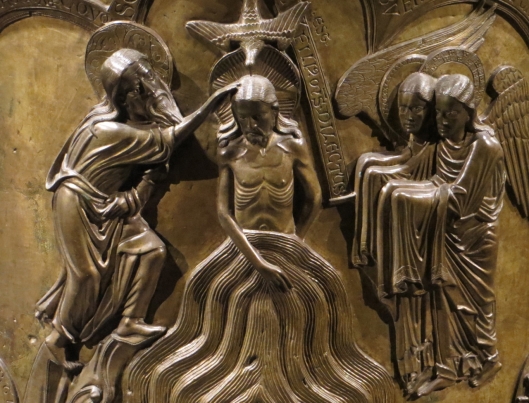
Baptismal Font (detail), copper alloy (c. 1226), Hildesheim Cathedral, Hildesheim, Germany. Photo by Reliquarian.
Saint Bernward of Hildesheim
During the Middle Ages, few individuals did more to support and develop the arts than Saint Bernward of Hildesheim. Considered one the era’s greatest patrons of the arts,1 Saint Bernward’s legacy included the commissioning of Hildesheim Cathedral’s monumental bronze doors2 and the construction of the abbey church of Saint Michael in Hildesheim.3 At a recent exhibition at the Metropolitan Museum of Art in New York, a number of objects commissioned by Saint Bernward, as well as other important objects from the treasury of Hildesheim Cathedral, were on display. The exhibition included several reliquaries, including a skillfully fashioned reliquary containing the skull of Saint Oswald and an arm reliquary that once held relics of Saint Bernward himself.
Saint Bernward was born to a noble Saxon family and served as the tutor of the future emperor Otto III before his appointment as Bishop of Hildesheim in 993. Hildesheim is one of the oldest cities in northern Germany, and the bishopric of Hildesheim was established by Louis the Pious, Charlemagne’s heir and successor, in 815.4 During the Middle Ages, Hildesheim was renowned for its metalworking, and many of Saint Bernward’s commissions would not have been possible if not for the extraordinary skill of the region’s metalsmiths. As noted in Medieval Treasures from Hildesheim, the proximity of nearby mines, which provided easy access to raw materials, “gave rise to a tradition of metalworking expertise that reached its peak during Bernward’s era.”5
The Golden Madonna (Virgin and Child Enthroned)

Golden Madonna, gold over linden wood, (c. 1022), Hildesheim Cathedral, Hildesheim, Germany. Photo by Reliquarian.
Neither Bernward’s Doors from Hildesheim Cathedral nor Bernward’s Column, an imposing bronze column circa 1015 representing “the first triumphal column since antiquity,” were on display at the Metropolitan Museum of Art, but the exhibition did include other impressive examples of the metalworkers’ art. The Golden Madonna, which dates to before 1022, has been attributed to Saint Bernward’s patronage.6 Sheathed in gold over a linden wood core, the depiction of the Virgin and Child enthroned is one of the oldest sculptures in the round from the Latin West.7
Reliquary of the Holy Cross
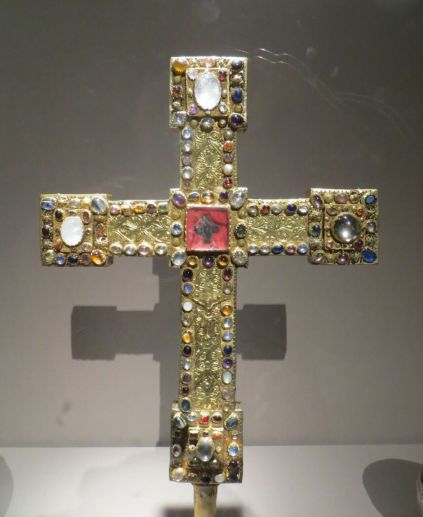
Cross Reliquary, gilded silver, rock crystal, and semiprecious stones, Hildesheim, Germany (c. 1180-1190), Hildesheim Cathedral, Hildesheim, Germany. Photo by Reliquarian.
A reliquary cross containing relics of the Holy Cross was also on display. According to legend, Henry the Lion, duke of Saxony and Bavaria obtained the relics from the Byzantine emperor in Constantinople during a pilgrimage to Jerusalem. On his safe return to Saxony in 1173, Henry allegedly donated the relics to the Church of the Holy Cross in Hildesheim, although no records supporting this story appear to exist.8 Nevertheless, the reliquary cross’s opulent gilding and intricately hammered ornamentation, as well as its impressive array of colored gems and rock crystal, attest to the significance of the darkened slivers of wood nestled at the center of the cross.
The Ringelheim Crucifix and Hidden Relics of Saints Cosmas and Damian
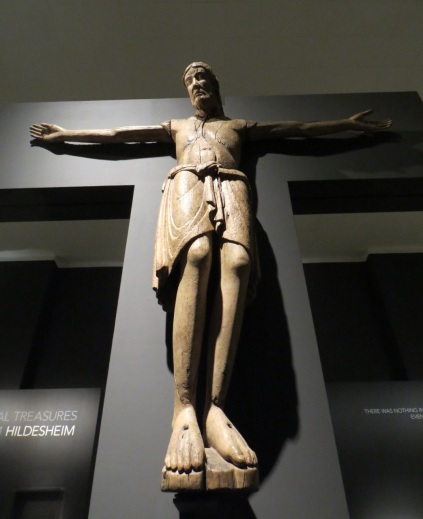
Ringelheim Crucifix, linden wood and oak (c. 1000). Photo by Reliquarian.
In addition to the Golden Madonna, Saint Bernward commissioned other large sculptures during his reign as bishop, including a striking wooden crucifix known as the Ringelheim Crucifix. Carved from linden wood and oak, the crucifix stands at over five feet tall and represents one of the most significant monumental wooden sculptures from the Ottonian period in existence today.9 Though carved as an object of devotion, conservation work conducted in the mid-20th century revealed that the crucifix also served as an inconspicuous reliquary. Concealed in a small cavity in Christ’s head, conservators discovered several relics, including two stones from the Holy Sepulcher and two bone fragments, wrapped in silk, of the twin saints Cosmas and Damian.10
Reliquary of Saint Oswald and the Story of His Skull
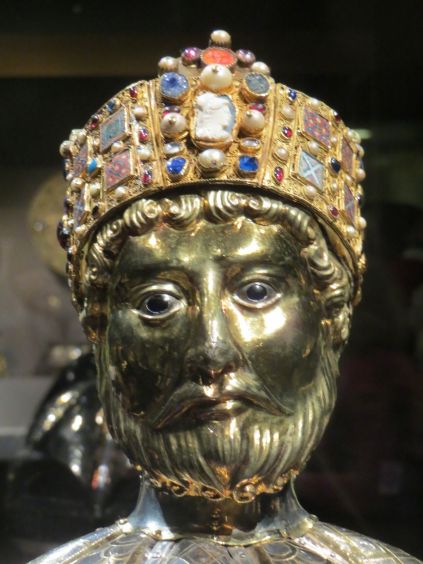
Reliquary of Saint Oswald, gold, silver, pearls, and gemstones over wood core (c. 1185-1189), Hildesheim Cathedral, Hildesheim, Germany. Photo by Reliquarian.
A more traditional reliquary, the Reliquary of Saint Oswald, was also on display at the exhibition. Richly crafted from gold and silver and embellished with niello, cloisonné, pearls, gemstones, and recycled Roman cameos and intaglios, the reliquary is regarded as a masterpiece of medieval goldsmithing.11 The reliquary’s most obvious and most striking feature is undoubtedly the gold bust of Saint Oswald placed atop the reliquary’s octagonal base. The saint’s eyes, finished in niello, were eerie and arresting, their blackened pupils eternally transfixed on the middle distance. Meanwhile, the saint’s crown seemed remarkable for its odd fit. I later learned that the crown and its decoration were cobbled together from earlier components, including a Roman cameo prominently displayed at the crown’s center.12 Apparently, sovereigns occasionally donated their own crowns to churches for reuse on bust reliquaries, although whether this happened to be the case with the Reliquary of Saint Oswald is unclear.13
 The Reliquary of Saint Oswald was designed to carry the skull of Saint Oswald, and the relic is evidently still enclosed within the reliquary, wrapped in silk. Saint Oswald was a King of Northumbria who lived in the early 7th century.14 According to the Venerable Bede, Saint Oswald was killed in battle by the pagan king of the Mercians at a place called Maserfield in 642.15 The Venerable Bede observes that the extent of Saint Oswald’s faith and devotion were made evident by the miracles that occurred at the spot where he died in battle.16 “[I]nfirm men and cattle are healed to this day,” he reports, and as a consequence, “many took up the very dust of the place where his body fell, and putting it into water, did much good with it to their friends who were sick.”17 In their enthusiasm for this holy dust, the people eventually carried away so much dirt that “there remained a hole as deep as the height of a man.”18
The Reliquary of Saint Oswald was designed to carry the skull of Saint Oswald, and the relic is evidently still enclosed within the reliquary, wrapped in silk. Saint Oswald was a King of Northumbria who lived in the early 7th century.14 According to the Venerable Bede, Saint Oswald was killed in battle by the pagan king of the Mercians at a place called Maserfield in 642.15 The Venerable Bede observes that the extent of Saint Oswald’s faith and devotion were made evident by the miracles that occurred at the spot where he died in battle.16 “[I]nfirm men and cattle are healed to this day,” he reports, and as a consequence, “many took up the very dust of the place where his body fell, and putting it into water, did much good with it to their friends who were sick.”17 In their enthusiasm for this holy dust, the people eventually carried away so much dirt that “there remained a hole as deep as the height of a man.”18
The Venerable Bede further explains that Saint Oswald’s head was originally buried in Lindisfarne. The Venerable Bede writes that after the Battle of Maserfield, the king of the Mercians commanded that Saint Oswald’s head, hands, and arms “be cut off from the body, and set upon stakes.”19 Returning with an army the next year, Saint Oswald’s successor, Oswy, removed the slain king’s body parts from their stakes and eventually buried Saint Oswald’s head at Lindisfarne Abbey. A century later, Saint Oswald’s head was translated to Durham Cathedral, where it was reburied with the body of Saint Cuthbert and the Venerable Bede himself.20 In 1538, however, under the authority of King Henry VIII, the relics of Saint Cuthbert and Saint Oswald were removed from their shrine and were deposited in an unmarked grave behind the high altar of Durham Cathedral.21 According to some sources, the relics of Saint Oswald were eventually destroyed during the Reformation—though perhaps his skull survived, cosseted away in an opulent reliquary.22
Arm Reliquary of Saint Bernward

Army Reliquary of Saint Bernward, silver, gold, and semiprecious stones over wood core (c. 1194), Hildesheim Cathedral, Hildesheim, Germany. Photo by Reliquarian.
The exhibition also included an arm reliquary that once held the relics of Saint Bernward. Reliquaries in the shape of body parts, also called “speaking reliquaries” (redende Reliquiare), first gained popularity in the 11th century and were intended to evoke the character of the relics they contained.23 So, for example, leg reliquaries held leg bones, and foot reliquaries held foot bones. In the Permanent Exhibition of Religious Art in Zadar, Croatia I even encountered a shoulder blade reliquary, shaped somewhat like a baby grand piano, that allegedly contained the shoulder blade of Saint Mark.24

Church of Saint Donatus, Zadar, Croatia. The church of Saint Donatus is located across the street from the convent of Saint Mary and the Permanent Exhibition of Religious Art. Photo by Reliquarian.
In his superb study on relics, Holy Bones, Holy Dust, Charles Freeman argues that arm reliquaries sometimes served an additional purpose beyond that of mere identification. Freeman notes that after Mass, celebrants traditionally blessed their congregations before they departed.25 Freeman writes that a blessing given by a bishop “was of a much higher status [than] that by a mere priest, and congregations often felt they had been badly done by. Yet if a priest held up an arm reliquary and blessed the congregation with that, it was believed to have the same effect as if the bishop himself had been there.”26 The posture of the Arm Reliquary of Saint Bernward—its right index finger and middle finger extended to heaven, its thumb curled slightly inward—suggests that it may occasionally have been used for this purpose, to deliver the final blessing. Another arm reliquary in the permanent collection of the Metropolitan Museum of Art, the Arm Reliquary of Saint Valentine, likely served a similar function.

Army Reliquary of Saint Valentine, silver, gilded silver, and blue cabochon, Basel, Switzerland (c. 1380-1400), Metropolitan Museum of Art, New York. Photo by Reliquarian.
Because of his patronage of the arts and his own reputed skill as an architect and artist, Saint Bernward is recognized today as a patron saint of architects, goldsmiths, painters, and sculptors. While the church he helped build, the abbey church of Saint Michael, may be his most conspicuous achievement, he accomplished so much more as a bishop and patron of the arts.27 As Medieval Treasures from Hildesheim states, “While many of Hildesheim’s bishops endowed its institutions with extraordinary works of art, no donor was more prolific or had a more significant impact on Hildesheim’s production than Bernward, the thirteenth bishop of Hildesheim.”28
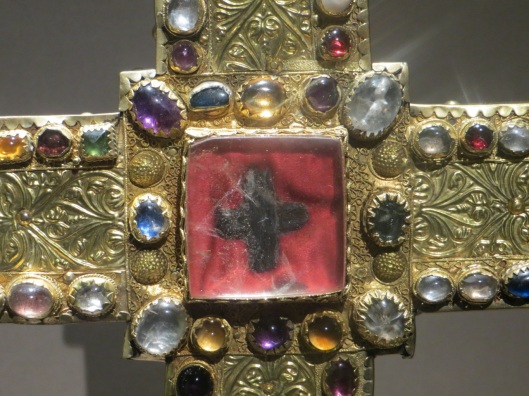
Cross Reliquary (detail), gilded silver, rock crystal, and semiprecious stones, Hildesheim, Germany (c. 1180-1190), Hildesheim Cathedral, Hildesheim, Germany. Photo by Reliquarian.

Arm Reliquary of Saint Bernward (detail), silver, gold, and semiprecious stones over wood core (c. 1194), Hildesheim Cathedral, Hildesheim, Germany. Photo by Reliquarian.

Small Bernward Cross, copper alloy, gilding, and semiprecious stones, Hildesheim, Germany (c. 1170-1180), Hildesheim Cathedral, Hildesheim, Germany. Photo by Reliquarian.
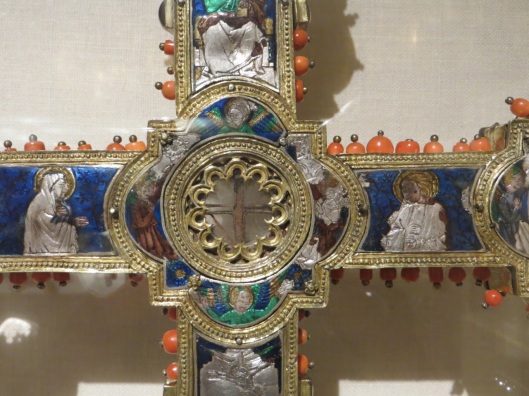
Reliquary Cross (detail), silver, gilded silver, enamel, coral, and rock crystal, Italy (the Marches), c. 1375-1400, Metropolitan Museum of Art, New York. This reliquary cross from the late 14th century is part of the permanent collection of the Metropolitan Museum of Art. Slivers of wood can still be seen encased at the center of the cross. Photo by Reliquarian.

Metropolitan Museum of Art, New York, New York. Photo by Reliquarian.
1 Metropolitan Museum of Art, Medieval Treasures from Hildesheim 6 (Peter Barnet et al. eds., 2013).
2 Id. at 11. According to Medieval Treasures from Hildesheim, the casting of Bernward’s enormous and highly decorated bronze doors, now known as Bernward’s Doors, was “a technological breakthrough for the Middle Ages and a milestone in the history of art.” Id.
3 Id. at 7.
4 Id. at 3.
5 Id. at 14, 16.
6 Id. 42.
7 Id.
8 Id. at 86.
9 Id. at 44.
10 Id. Medieval Treasures from Hildesheim further notes that other monumental crucifixes similarly served as reliquaries.
11 Id. at 88.
12 Id.
13 Id. Examples of this reuse can be found at Prague Cathedral and Saint-Denis in Paris.
14 Charles Freeman, Holy Bones, Holy Dust 63 (2011).
15 Saint Bede, The Venerable Bede’s Ecclesiastical History of England 123 (J. A. Giles ed., 1847).
16 Id. at 123–24.
17 Id. at 124.
18 Id.
19 Id. at 129.
20 Saint Bede, 1 The Complete Works of Venerable Bede: Life, Poems, Letters, Etc. at xcviii, xciii (J. A. Giles trans., 1843); Thomas J. Craughwell, Saints Preserved 228–29 (2011).
21 Craughwell, supra note 20, at 229.
22 Id.
23 Freeman, supra note 14, at 82.
24 The Permanent Exhibition of Religious Art is also more informally known as the “Gold and Silver of Zadar.” Located in the Benedictine convent next to the church of Saint Mary, the exhibition includes an overwhelming and truly extraordinary collection of relics and other sacred objects, the oldest of which—a small pectoral cross—dates from the 8th century. See Ivo Petricioli, The Permanent Exhibition of Religious Art in Zadar at VIII (2004). According to Michelin, the museum itself is “[o]ne of the best museums in Croatia.” Sacred Art Museum, Michelin Travel, http://travel.michelin.com/web/destination/Croatia-Zadar/tourist_site-Sacred_Art_Museum-Trg_Opatice_Cike. The Reliquary of the Shoulder Blade of Saint Mark, which is fashioned of embossed gilded copper metal plate, is estimated to date to the 13th century.
25 Id.
26 Id.
27 Medieval Treasures from Hildesheim suggests that the original structure of the church may have been preserved over the centuries “because Bernward’s sainthood and supposed involvement as an architect and artist gave St. Michael’s itself the status of a relic.” Metropolitan Museum of Art, supra note 1, at 7.
28 Id. at 6.
